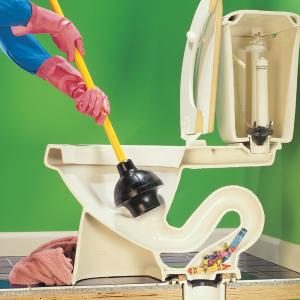
Clogged toilet? No problem. With a little practice, even a home repair rookie can get most clogged toilets back up and running in minutes, without flooding the bathroom and making the situation worse. In this article we'll show you how to avert a morning household disaster by clearing a clogged toilet fast.
By the DIY experts of The Family Handyman Magazine
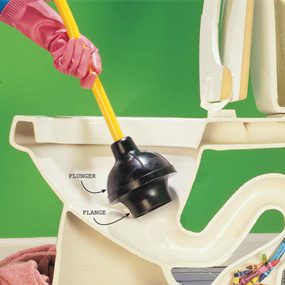
Photo 1: Grab the plunger
Plunge the toilet with the rubber flange pulled out to get a better seal. Push in and out vigorously, keeping enough water in the bowl to cover the plunger. Keep towels handy to wipe up water that splashes out.
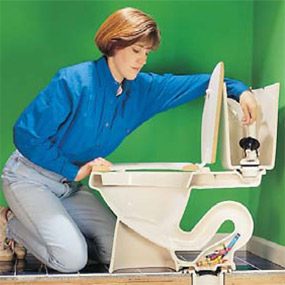
Photo 2: Test for a clog
Don't flush the toilet if you suspect that it's clogged. Instead, remove the tank lid and lift the flapper valve slightly to let a cup or two of water into the bowl to see if the water goes down. Flushing a clogged toilet may flood your floor!
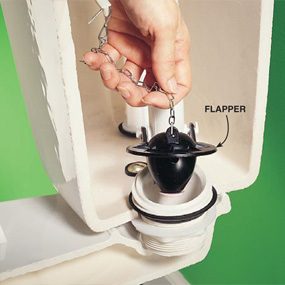
Close-up of Photo 2
Lift the flapper slightly to release a little water.
For about 90 percent of clogged toilets, you only need one special tool—a plunger. Buy one with an extension flange on the rubber bell-shaped end (lead photo). It's designed to fit toilets better so you can deliver more “oomph” to the plunge. You could pull a woodchuck from a hole with one of these things. It'll unplug sink and tub drains too, if you simply fold the flange back into the bell.
A poor flush means that your toilet drain is either partially or completely plugged. A toilet that's completely plugged—a no-drainer—is obvious. The toilet bowl will fill to the brim with flush water and perhaps overflow. Give the water level 10 minutes or so to drop, then attack the problem with a plunger (Photo 1).
However, most clogged toilets are slow drainers, that is, flush water partially fills the bowl but doesn't rush out and clean away the waste. The water level remains high, then usually drains down to normal height within a minute or two. You might not know the toilet is clogged until you flush it. So if you suspect a problem, test the drainage first as we show in Photo 2. If it doesn't drain, don't flush it. Reach for the plunger.
Photo 1 shows how a plunger fits over and seals the toilet drain. Wear rubber gloves—things can get messy—and follow these plunging tips:
- Make your first plunge a gentle one. Initially the bell is full of air. A hard thrust will force the air back around the seal and blow water all over the bathroom and you!
- Once you force out the air, plunge vigorously in and out, maintaining the seal. You'll be forcing water both directions in the drain, which will effectively loosen most clogs. Stick with it, plunging 15 to 20 times if necessary.
- Be patient. Try alternating between steady strokes and occasional monster heaves.
- Keep enough water in the bowl so the plunger stays covered. Trying to force air through the toilet trap won't generate much pressure.
Step 2: Reach for the snake
Spin the long flexible wire into the drain to snag the clog and pull it out.
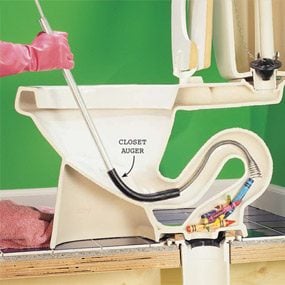
Photo 4: A closet auger
Spin a special “closet auger” or regular snake through the drain if plunging doesn't dislodge the clog. The wire coil end should break through the obstruction or grab it so you can pull it out.
If the plunger won't open the drain, or if you can force out the water with the plunger but the toilet still won't flush well, reach for the snake (Photo 3). A drain snake is a long wire coil with a corkscrew-like tip that you feed into your pipes until it encounters the clog. Then you turn the snake clockwise, so that the tip screws into or through the clog and breaks it up. Or the debris winds onto the wire so you can pull it out.
Even the least expensive snake (Photo 3) will clear a toilet. But the closet auger (Photo 4) is a special type designed to get around the first bend, keep debris at arm's length, and yet still spin the coil to hook “foreign objects.” A rubber sleeve protects the enamel bowl from scrape marks. These snakes are short because most obstructions catch in the first S-bend or at the floor flange. (Plumbers report that the most common foreign objects are toys.)
Step 3: Major surgery if all else fails
If the clog resists all your efforts, you'll probably have to pull up the toilet. This job will take several hours, because you have to turn off and unhook the water supply, partially disassemble the toilet, and unscrew it from its mounting ring. Chances are, you can then get at the problem. Be sure to buy a new wax ring and new mounting bolts to reseal the toilet base to the mounting ring.However, if other drains in your home are plugged, or if water comes up through them, the problem is probably farther down in the main drainpipes, often out of easy reach. For those clogs you may have to call a plumber. Plumbers are expensive, but they can put your bathroom back in service fast, even if there's a major blockage.
Toilet Do's and Don'ts
1. Avoid chemicals. Don't be suckered into thinking that powerful chemicals will do the messy work for you. They sometimes work, but they're slower. And when they don't work, you have a drain full of corrosive water on your hands. If you tried chemicals and they didn't work, run as much water into the toilet as possible and let it sit overnight to drain through the clog. Then, when you plunge, wear safety goggles and rubber gloves to keep the water out of your eyes and off your bare skin.
2. Keep the toilet cover down, especially if you have small kids, so toys and hairbrushes won't fall into the toilet.
3. Don't pour hardening compounds down the toilet. These include such things as drywall joint compound, grease, caulk and wax products.

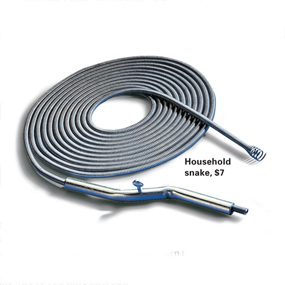
Thanks for posting this for the benefit of your readers! It surely helps to know a few plumbing skills such as removing clogs from your toilet, instead of having to call the plumber all the time. This will save you money. Of course, for major repairs, it’s better to seek professional help, as a DIY may make the problem worse and you will end up having to spend more for the repair.
ReplyDeleteSheryl August